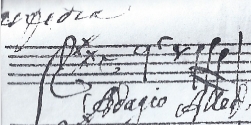As we saw in the previous sections, one main feature in the Torelli's concerto-form is the presence of a multisectional second movement. The central part of it is always a fast, virtuosistic episode, characterized by the athematic and figural movement of the solo voice. This is the so-called Perfidia. This word comes from the Latin “per fides”, which means 'through the strings'. A definition of it can be found in the treatise: Documenti Armonici by Angelo Berardi (Bologna, 1687), who writes that the Perfidia consists of “continuare un passo a capriccio del compositore” [to continue a passage according to the fantasy of the composer]. A similar explanation is given also by S. de Brossard in his Dictionnaire de la Musique (Paris,1703); J. G. Walther in his Musikalisches Lexicon (Leipzig, 1732); J. J. Rousseau in his Dictionnaire de la Musique (Paris, 1781): the Perfidia is represented by a reiteration of certain patterns, such as: arpeggios, scales, broken chords.
The perfidia is used by Torelli almost systematically in his compositions and it can be considered as an ancestor of the cadenza or capriccio: it is, in fact, the section in which the soloist/soloists can show off his/their technical skills over a reduced orchestral accompaniment. However, the perfidia still remains a concertante composition, in which an accompaniment part for the continuo and sometimes for the whole orchestra is always provided; while in the cadenza the soloist is left completely alone. The presence of three perfidie for two violins and continuo in the Archive of San Petronio allow us to infer that these sections could have been written also separately, in order to be performed when it would have become necessary according to the liturgical needs.
Certainly the habit of performing and improvising figural solo passages was of relevance to any virtuoso. In Torelli's concertos production not only perfidie are included sistematically, as priviledge sections where to exhibite the abilities of the soloist, but it is possible to find also one of the very first example of Cadenza a capriccio: in the concerto A.2.3.10, the manuscript of it - copied by Pisendel - is held at the SLUB in Dresden (Mus. 2035-O-4), the second movement is multisectional with its canonic perfidia in the middle section; moreover at the end of the third movement the solo violin is free to improvise a cadenza, for which Torelli left only written out the first bars, leaving to the fantasy of the performer the continuation of it.

